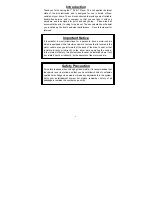
PXIe-5673E Calibration Procedure
|
© National Instruments
|
27
•
Reference clock source: External
•
Frequency counter resolution: 1 Hz
5.
Verify that the measurement in step 4 is within the 9 ppm test limit, with respect to
400 MHz.
If the results are within the selected test limit, the device has passed this portion of the
verification.
Adjustment
To adjust the PXIe-5673E to meet published specifications, you must adjust the modules that
comprise the PXIe-5673E system. To calibrate the PXIe-5650/5651/5652, PXIe-5450, and
PXIe-5611 modules individually, refer to their calibration procedures at
ni.com/manuals
.
Reverification
Repeat the
section to determine the as-left status of the device.
Note
If any test fails reverification after performing an adjustment, verify that you
have met the
before returning your device to NI. Refer to
for information about support resources or service requests.
Updating Calibration Date
Performing any adjustment procedure on the PXIe-5611 updates the calibration date.
If you do not want to perform an adjustment, you can update the calibration date without making
any adjustments by initializing an external calibration and closing the external calibration.
1.
Call the niRFSG Initialize External Calibration VI.
2.
Call the niRFSG Close External Calibration VI to close the session. Set the
write
calibration to hardware?
parameter to TRUE to store the results to the EEPROM on the
PXIe-5673E.
Worldwide Support and Services
The NI website is your complete resource for technical support. At
you have
access to everything from troubleshooting and application development self-help resources to
email and phone assistance from NI Application Engineers.
for NI Factory Installation Services, repairs, extended warranty, and
other services.
to register your NI product. Product registration facilitates technical
support and ensures that you receive important information updates from NI.


































